One of the most important things we do at ISDSI is to meet and talk with local communities and activists while setting up and preparing a course. We refer to our courses as “community based” since they are both physically based in a community, as well as intellectually based in a community—we want the community to be the ones helping decide what to teach, what is important, and how it all fits together. Once we get into the community with the students our role as instructors changes to be facilitators—letting the villagers step up and teach the students, sharing their lives, their wisdom, and their vision for creating a more sustainable world.

Looking across the Mekong river to Laos. (Note how low the water is, and the riverside gardens!)
To do this takes a lot of prep work, going out to villages, talking with folks about their passions, concerns and problems, and working together to find a way to teach American students about it. It isn’t easy, but it is really important. We’ve got to sort out logistics (how many hours to get to that village?), housing (how many people per house?), curriculum and lesson flow (what do we do first? last?), and find dynamic and interesting speakers and topics that are engaging and meaningful for both the local communities and the American students.
We also are constantly evaluating and assessing courses. Are they engaging? Are students learning from them? Is this the best way to teach this? Are there better or more important places to go? What other topics need to be in the course? What can we drop, and still retain the core lessons?
This spring we’ve decided to work on the Rivers course. The core of the course is about how local communities are impacted by decisions by the State, and often how the local livelihoods are sacrificed for (often dubious) benefits for urban people far from the rivers. To do this we study two well known rivers in Thailand—the Yom, which is not yet dammed, and the Mun, which has been dammed to the great destruction of local communities and the ecology, with few benefits to show from it.
We’ve always included discussions of the Mekong river in the course—the Mun is an important tributary, and damming the Mun impacts the ecology of the Mekong. The Mekong also represents a good example of the problems of rivers crossing boundaries, upstream/downstream resource control, etc. With China already damming the Mekong, and Thailand and Laos talking about damming it themselves, we’ve decided we need to incorporate the Mekong more directly into the course, and refine the links from the communities on the Mun river to what is happening on the Mekong.
So we had to talk with the folks involved in both the Mun and the Mekong, which meant doing a recon to Issan, hours away from Chiang Mai by van, to the Northeast region of Thailand.



